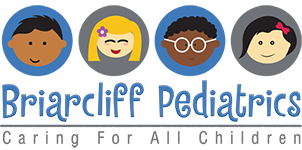A Fun Way to Teach Kids About Germs
- On Sep, 20, 2018
- Doctor Notes
- Latest News
At Briarcliff Pediatrics, we’re always on the lookout for fun ways to help kids learn good hygiene. Regular handwashing is an essential hygiene practice for kids and adults alike, and there’s no telling how many lives are saved every year by this now-routine practice. We take it for granted today, but the germ theory of disease has only been widely accepted for a little over 100 years. For the considerably longer amount of time humans had been getting sick before that, we didn’t realize that we were spreading harmful microbes from surface to surface, person to person, and hand to face. Given how long it took us to figure that out, it’s no surprise that kids don’t seem to easily develop the habit of handwashing.

It’s important to teach kids to wash their hands early on. The Centers for Disease Control (CDC) estimates that teaching people about handwashing reduces respiratory illnesses, like colds, by 16–21% in the general population. Flu season is coming up, and besides vaccinating everyone we can against the flu, one of the best and easiest ways to prevent its spread is through regular, thorough handwashing. Although it may seem difficult to make handwashing fun, we can educate and entertain with an activity we’ll call “glitter theory.” First, sprinkle a small pile of glitter on a table and have your child press their hands into it. Then, have them put their hands on a few different surfaces, one after another. Door handles, seats, the floor, other people’s hands—get as creative with it as you like with it. Of course, make sure that the surfaces your child touches are clean before you get started. Keep in mind that this activity entails a small amount of glitter cleanup.
These days, there are countless ways to teach your children about health, but this is a great activity for teaching two principles: the reason we wash our hands, and why we should do it rigorously. Once your child can see the sparkly pestilence left in their wake, you’ll have a nice visual aid for illustrating how germs work. And once they see how thoroughly they must scrub to wash the glitter away, they’ll have a better idea of how much time to put into standard handwashing (15–20 seconds of forceful, exhaustive scrubbing, as recommended by the CDC). One common way of getting kids to continue reaching 20 seconds every time they wash their hands is the old “sing ‘Happy Birthday’ twice” exercise. Remind them to wash their hands with that same persistence every time they do it. You may even teach an additional lesson about the stubbornness of germs by enlisting your child’s help in the overall cleanup.
Explain that germs spread in much the same way glitter does, only that they’re invisible and everywhere. However, you may want to wait until they’re of a certain age to explain that germs are innumerable living creatures from which there’s no hope of escape. The object is to inform, not to overwhelm. Germs are an essential aspect of our biology and environment that, on balance, do far more good than harm. Nonetheless, we need to limit how much we spread them around to keep the bad ones at bay and protect everyone’s health.
Dr. Ray Deeb and Dr. Ashley Brown provide comprehensive healthcare for newborns and children up to the age of 18, and they’re currently accepting new patients. If you would like to learn more about us, contact Briarcliff Pediatrics to schedule an appointment or a complimentary meet-and-greet, during which you can talk in person with Dr. Deeb or Dr. Brown and get a tour of our newly renovated office. Don’t forget to follow us on social media to get the latest health tips and news in children’s health care, and check back often for new blogs.




